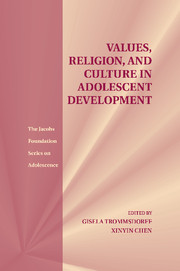Book contents
- Values, Religion, and Culture in Adolescent Development
- Series page
- Values, Religion, and Culture in Adolescent Development
- Copyright page
- Dedication
- Contents
- Contributors
- Preface
- Acknowledgments
- Part One Theoretical Perspectives on Values, Religion, and Adolescent Development in Cultural Context
- Part Two Universal and Culture-specific Functions of Adolescent Values and Religion
- Part Three Impact of Values and Religion on Adolescent Adjustment in Times of Social Change
- 9 Marginalized Japanese Youth in Post-industrial Japan
- 10 Adolescent Cultural Values and Adjustment in the Changing Chinese Society
- 11 With God’s Help
- 12 Religion’s Role in the Development of Girls’ Occupational Aspirations
- 13 First Romantic Relationships of Adolescents from Different Religious Groups in Israel and Germany
- Part Four Socialization Processes of Values and Religion in Adolescent Development
- Index
11 - With God’s Help
The Future Orientation of Palestinian Girls in Israel Growing Up Muslim
from Part Three - Impact of Values and Religion on Adolescent Adjustment in Times of Social Change
Published online by Cambridge University Press: 05 September 2012
- Values, Religion, and Culture in Adolescent Development
- Series page
- Values, Religion, and Culture in Adolescent Development
- Copyright page
- Dedication
- Contents
- Contributors
- Preface
- Acknowledgments
- Part One Theoretical Perspectives on Values, Religion, and Adolescent Development in Cultural Context
- Part Two Universal and Culture-specific Functions of Adolescent Values and Religion
- Part Three Impact of Values and Religion on Adolescent Adjustment in Times of Social Change
- 9 Marginalized Japanese Youth in Post-industrial Japan
- 10 Adolescent Cultural Values and Adjustment in the Changing Chinese Society
- 11 With God’s Help
- 12 Religion’s Role in the Development of Girls’ Occupational Aspirations
- 13 First Romantic Relationships of Adolescents from Different Religious Groups in Israel and Germany
- Part Four Socialization Processes of Values and Religion in Adolescent Development
- Index
Summary
This chapter examines how Sunni Muslim girls in Israel construct their future orientation. Underlying are three basic premises: (1) adolescent future orientation plays a pivotal role in guiding entrance to adulthood, (2) future orientation is shaped by contextual forces including religious–cultural setting and family environment, and (3) religious practices are shaped by local circumstances. The article consists of three parts: (1) the conceptualization of future orientation, (2) the developmental setting of Muslim girls in Israel, and (3) how they construct their future orientation. This part presents a six-step model depicting future orientation, its family antecedents and academic achievement outcomes, and empirical estimates for two pertinent future life domains: higher education and marriage and family. Employing a mixed-method approach, quantitative analyses (Structural Equation Modeling) show a good fit for each of the two empirical models. Yet, higher education has a positive effect and marriage and family has a negative effect on academic achievement. Qualitative analyses of their hopes and fears narratives indicate that these girls resolve the tension between devotion to religious-traditional life via early marriage and aspirations for emancipation via higher education by following three strategies: completing education before getting married, marrying a supportive husband, and harnessing education for the good of the collective.
- Type
- Chapter
- Information
- Values, Religion, and Culture in Adolescent Development , pp. 253 - 270Publisher: Cambridge University PressPrint publication year: 2012
- 10
- Cited by



